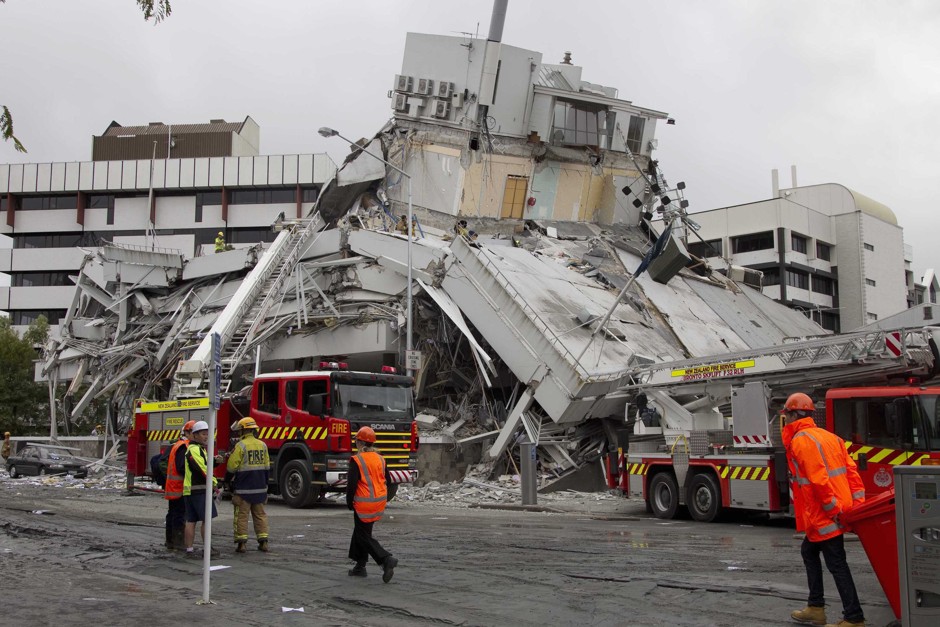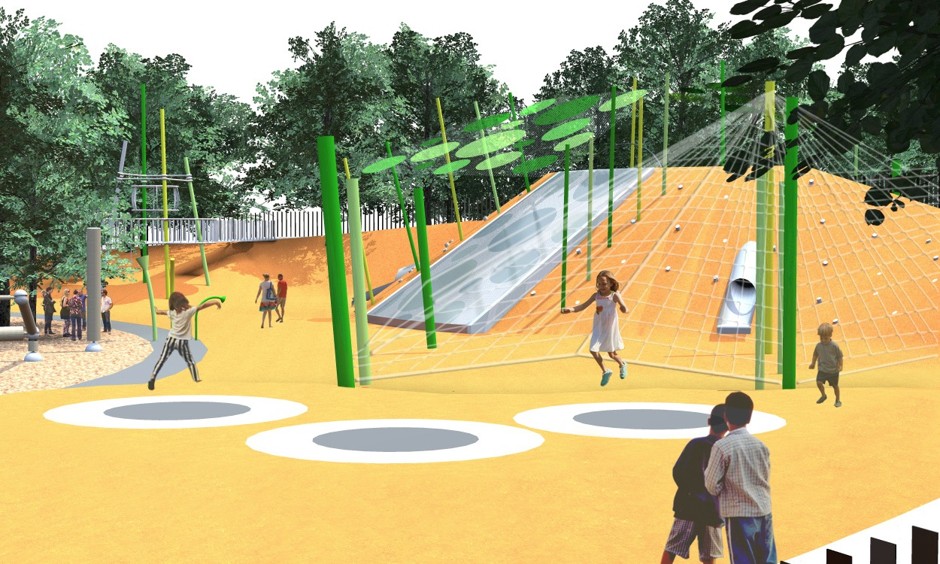
When two devastating earthquakes hit Christchurch, New Zealand,
in 2010 and 2011, they leveled the central city and beyond,
killing 185 people and triggering aftershocks that lasted for months.
in 2010 and 2011, they leveled the central city and beyond,
killing 185 people and triggering aftershocks that lasted for months.
Four years later, much of the central city still looks barren, with blocks
and blocks of razed gravel lots. The rebuild has been estimated
at $26 billion (in U.S. dollars) and the 2011 quake alone was the world’s
third most expensive insured disaster.
and blocks of razed gravel lots. The rebuild has been estimated
at $26 billion (in U.S. dollars) and the 2011 quake alone was the world’s
third most expensive insured disaster.
But the rebuild is slowly gaining momentum, and the plans involve
a broad slice of the population.
Even 12-year-old Harriet Compton-Moen has played an important role.
In 2013, along with three other students at Selwyn House School,
Compton-Moen devised the concept behind what will be one of the
largest outdoor play areas in the world.
a broad slice of the population.
Even 12-year-old Harriet Compton-Moen has played an important role.
In 2013, along with three other students at Selwyn House School,
Compton-Moen devised the concept behind what will be one of the
largest outdoor play areas in the world.

Left to right, students Zelle Logan, Harriet Compton-Moen,
and Enya O'Malley discuss their playground design.
(Christchurch Central Development Unit)
and Enya O'Malley discuss their playground design.
(Christchurch Central Development Unit)
about rebuilding and found there was a strong desire for new playgrounds
and family-friendly spaces. In 2013, The Amazing Place competition
—run by the government and sponsored by the Bank of New Zealand—
challenged children to design “the world’s best playground.”
The competition drew 300 entries from around 6,000 local children from
preschool to Year 6 (5th grade)
The winning concept, from Compton-Moen’s team, was inspired by
local children’s writer Margaret Mahy. Now much evolved, the original
design featured a dragon-tongue slide, rainbow-colored mulch,
witch-in-the-cherry-tree swings, and a giant castle of creamy yellow brick.
local children’s writer Margaret Mahy. Now much evolved, the original
design featured a dragon-tongue slide, rainbow-colored mulch,
witch-in-the-cherry-tree swings, and a giant castle of creamy yellow brick.
The $13 million Margaret Mahy Family Playground is due to be finished
by Christmas. Its design was led by the planning consultants Opus,
with the design firm Boffa Miskell, Christchurch City Council,
Te Rūnanga o Ngāi Tahu (the Māori tribal council), and the playground
equipment supplier PlayRope.Officials hope it will draw children
and families back into the central city, which was closed for more than
two years following the second quake.
Overall, the rebuild has been painfully slow; some have
criticized the government’s approach, and
symptoms of post-traumatic stress have been widespread among
both adults and children in Christchurch.
by Christmas. Its design was led by the planning consultants Opus,
with the design firm Boffa Miskell, Christchurch City Council,
Te Rūnanga o Ngāi Tahu (the Māori tribal council), and the playground
equipment supplier PlayRope.Officials hope it will draw children
and families back into the central city, which was closed for more than
two years following the second quake.
Overall, the rebuild has been painfully slow; some have
criticized the government’s approach, and
symptoms of post-traumatic stress have been widespread among
both adults and children in Christchurch.

Rescue crews in central Christchurch, Feb. 22, 2011 (Simon Baker / Reuters)
“They looked at, for example, samples of rope, the color palette,
[and] the design of the play equipment, and gave us their feedback
on what they loved and what would make the playground even better,”
Kerr says. They were encouraged to think about their ideas in the
context of site conditions like scale, shade, and noise.
[and] the design of the play equipment, and gave us their feedback
on what they loved and what would make the playground even better,”
Kerr says. They were encouraged to think about their ideas in the
context of site conditions like scale, shade, and noise.
The final, 2.5-acre playground is designed around local stories
—those of Mahy and another children’s writer, Elsie Locke, and from
the Māori tribe Ngāi Tahu. It is divided into four areas reflecting
Canterbury’s varied landscape: a forest zone, coastal zone,
plains zone, and wetland zone.
—those of Mahy and another children’s writer, Elsie Locke, and from
the Māori tribe Ngāi Tahu. It is divided into four areas reflecting
Canterbury’s varied landscape: a forest zone, coastal zone,
plains zone, and wetland zone.

A rendering of the trampoline area in the coastal zone (Christchurch Central Development Unit)
The stylized forest, Kerr says, “provides a setting for high-energy play”
on elements such as climbing towers and nets, and will appeal
to older children, while the coastal zone, with sandy play areas
and a discovery garden, is intended for younger kids.
on elements such as climbing towers and nets, and will appeal
to older children, while the coastal zone, with sandy play areas
and a discovery garden, is intended for younger kids.
The playground will also include a slide 13 feet wide, a fitness trail,
picnic areas, and a café, as well as an interactive lighting design
to make it a social space in the evenings.
picnic areas, and a café, as well as an interactive lighting design
to make it a social space in the evenings.
As part of The Amazing Place initiative,
another competition was held for older children to help rebuild
Christchurch’s central business district. Local middle- and high-school
students were asked to devise a major development or anchor project.
another competition was held for older children to help rebuild
Christchurch’s central business district. Local middle- and high-school
students were asked to devise a major development or anchor project.
Winning projects include a seismograph sculpture which shows
the amplitude of the 2011 earthquake; a retail precinct featuring
a basketball court and ice rink; and a “social center”
in the main city square. The Christchurch Central Development Unit
made a series of videos displaying the students’ projects.
the amplitude of the 2011 earthquake; a retail precinct featuring
a basketball court and ice rink; and a “social center”
in the main city square. The Christchurch Central Development Unit
made a series of videos displaying the students’ projects.
Prioritizing children’s role in the rebuild encourages young people
to strengthen their bond with the city.
This kind of connection between kids and the urban landscape could
be fostered anywhere. But the need is particularly strong in Christchurch,
where the population declined by 2 percent following the earthquakes.
to strengthen their bond with the city.
This kind of connection between kids and the urban landscape could
be fostered anywhere. But the need is particularly strong in Christchurch,
where the population declined by 2 percent following the earthquakes.
In one of the videos about the competition, a student stands in one
of Christchurch’s vast gravel lots. “You know, we lost a lot of buildings,”
he says. “And it kind of gives us the space to build cooler ones.”
of Christchurch’s vast gravel lots. “You know, we lost a lot of buildings,”
he says. “And it kind of gives us the space to build cooler ones.”

Δεν υπάρχουν σχόλια:
Δημοσίευση σχολίου